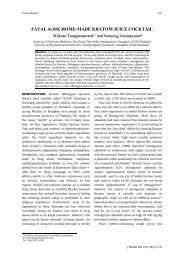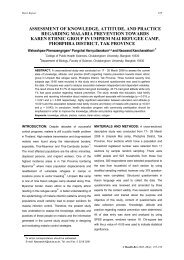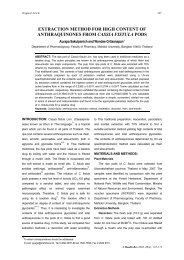antityrosinase and antibacterial activities of mangosteen pericarp
antityrosinase and antibacterial activities of mangosteen pericarp
antityrosinase and antibacterial activities of mangosteen pericarp
Create successful ePaper yourself
Turn your PDF publications into a flip-book with our unique Google optimized e-Paper software.
100 Original Article<br />
was run in isocratic fashion <strong>of</strong> 6% water in MeOH<br />
at flow rate <strong>of</strong> 1 ml/mim. The α-mangostin was<br />
detected at wavelength <strong>of</strong> 319 nm3) . The st<strong>and</strong>ard<br />
α-mangostin (>98 % purity) was dissolved in<br />
methanol to make a stock solution at<br />
concentration <strong>of</strong> 0.1 mg/ml. The stock solution<br />
was further diluted with methanol to make the<br />
st<strong>and</strong>ard concentrations <strong>of</strong> 20 μg/ml, 40 μg/ml,<br />
60 μg/ml, <strong>and</strong> 80 μg/ml. The st<strong>and</strong>ard curve <strong>of</strong><br />
α-mangostin was plotted between peak area ratio<br />
<strong>and</strong> concentration.<br />
Antityrosinase Assay<br />
Chemicals<br />
DL-DOPA, mushroom tyrosinase (T3824-<br />
25KU) <strong>and</strong> kojic acid were purchased from Sigma<br />
(USA).<br />
Inhibition <strong>of</strong> tyrosinase activity<br />
Tyrosinase activity inhibition was determined<br />
by the method as described earlier4) . In brief, MPC<br />
was dissolved in 95% ethanol to make the stock<br />
solutions at concentrations <strong>of</strong> 0.2, 0.02, 0.002,<br />
0.0002, <strong>and</strong> 0.00002 mg/ml, respectively. The<br />
96-well plate was prepared by applying 140 μl <strong>of</strong><br />
phosphate buffer pH 6.8, 20 μl <strong>of</strong> tyrosinase (48<br />
units/ml), 20 μl <strong>of</strong> sample, <strong>and</strong> 20 μl <strong>of</strong> 0.85 mM<br />
DL-DOPA to make the test concentrations <strong>of</strong> MPC<br />
at 0.01, 0.001, 0.0001, 0.00001, <strong>and</strong> 0.000001<br />
mg/ml, respectively. After incubation for 10<br />
minutes, the enzyme activity was determined by<br />
measuring the absorbance at 492 nm using the<br />
microplate reader (Anthos, Zenith 200rt)<br />
comparing to the control consisting <strong>of</strong> 95%<br />
ethanol instead <strong>of</strong> sample. Kojic acid (1 mg/ml)<br />
was used as positive control. Three independent<br />
experiments were performed <strong>and</strong> each experiment<br />
was run in triplicate. The percentage <strong>of</strong> tyrosinase<br />
inhibition was calculated as follows:<br />
%inhibition = (Acontrol-Ablank)-(Asample-AblankS) x 100<br />
(Acontrol-Ablank)<br />
Acontrol= Absorbance at 492 nm <strong>of</strong> the solution<br />
without sample but consisted <strong>of</strong> enzyme<br />
Ablank= Absorbance at 492 nm <strong>of</strong> the solution<br />
without sample <strong>and</strong> enzyme<br />
Asample= Absorbance at 492 nm <strong>of</strong> the solution<br />
with sample <strong>and</strong> enzyme<br />
AblankS= Absorbance at 492 nm <strong>of</strong> the solution<br />
without enzyme but consisted <strong>of</strong> sample<br />
J Health Res 2009, 23(2): 99-102<br />
Antibacterial assay<br />
Test organisms<br />
The bacterial strains used were Streptococcus<br />
pyogenes DMST17020, Staphylococcus aureus<br />
ATCC25923, Streptococcus mutans DMST18777,<br />
<strong>and</strong> Porphyromonas gingivalis DMST2136. All the<br />
bacteria were obtained from Thail<strong>and</strong> National<br />
Institutes <strong>of</strong> Health.<br />
All bacteria except P. gingivalis DMST2136<br />
were cultured on Tryptic soy agar (TSA) at 37°C<br />
for 24 h prior to use. The P. gingivalis DMST2136<br />
was cultured on Brucella agar with vitamin K <strong>and</strong><br />
hemin (BCA) at 37°C in anaerobic atmosphere for<br />
120 h prior to use.<br />
Chemicals<br />
Tryptic soy agar (TSA) <strong>and</strong> Brucella agar with<br />
vitamin K <strong>and</strong> hemin (BCA) were purchased from<br />
DifcoTM (USA) <strong>and</strong> Sigma-Aldrich (USA),<br />
respectively. Dimethylsulfoxide (DMSO) was<br />
purchased from Sigma-Aldrich (USA). The CO2<br />
pad (Anaerocult ® A) was purchased from Merck<br />
(USA).<br />
Agar dilution method<br />
The minimal inhibitory concentration (MIC)<br />
values were determined by the agar dilution<br />
method5) . In brief, the MPC was dissolved in<br />
10%DMSO (10 ml <strong>of</strong> DMSO in 90 ml sterile water)<br />
then diluted to achieve the concentration <strong>of</strong> 400<br />
mg/ml, 4 mg/ml, 0.4 mg/ml, 0.04 mg/ml, <strong>and</strong><br />
0.004 mg/ml, respectively. Each 0.5 ml <strong>of</strong> stock<br />
solution was mixed with 19.5 ml <strong>of</strong> molten TSA or<br />
BCA agar at 50°C until homogeneous before being<br />
poured into the sterile petridish <strong>and</strong> allowed to<br />
solidify in the sterile atmosphere. The final<br />
concentrations <strong>of</strong> tested samples were 10 mg/ml,<br />
1 mg/ml, 0.1 mg/ml, 0.01 mg/ml, <strong>and</strong> 0.001<br />
mg/ml, respectively.<br />
Microbial suspension in sterile water<br />
containing 108 CFU/ml <strong>of</strong> bacteria was adjusted<br />
to McFarl<strong>and</strong> No. 0.5 st<strong>and</strong>ard turbidity. A 20-μl<br />
<strong>of</strong> bacterial suspension was applied <strong>and</strong> spread<br />
on the TSA <strong>and</strong> incubated at 37°C for 24 h for S.<br />
mutans DMST18777, S. pyogenes DMST17020,<br />
<strong>and</strong> S. aureus ATCC25923. P. gingivalis<br />
DMST2136 was tested for susceptibility on BCA<br />
<strong>and</strong> incubated at 37°C in anaerobic atmosphere<br />
for 120 h by using anaerobic jar <strong>and</strong> Aerocult A ®







